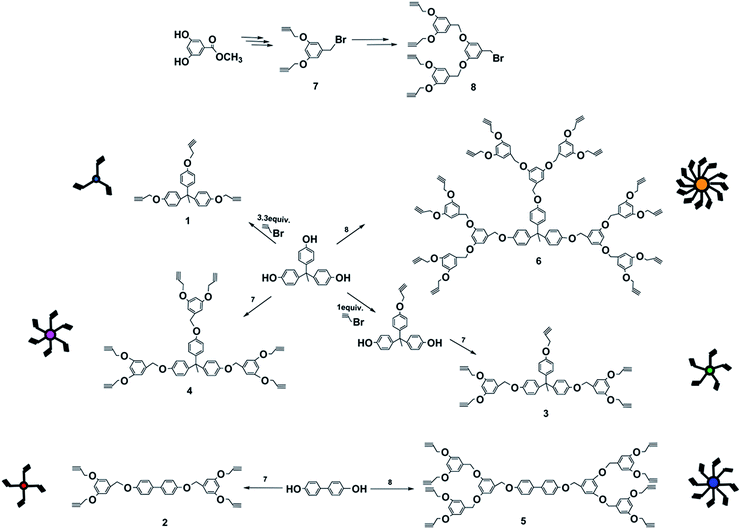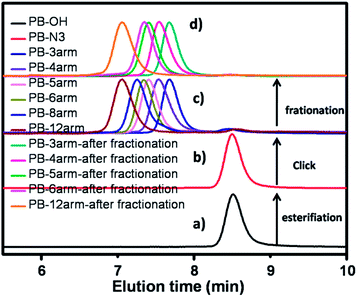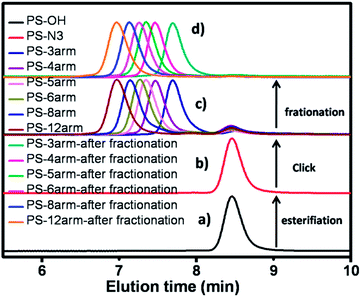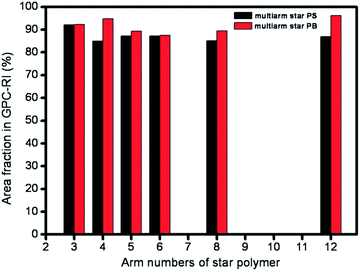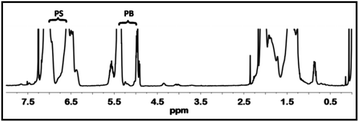Highly efficient synthesis and characterization of multiarm and miktoarm star-long-branched polymers via click chemistry†
Li Maa,
Yichao Linab,
Haiying Tanab,
Jun Zhengab,
Feng Liuab,
Guangchun Zhangab,
Jie Liu*a and
Tao Tang*a
aState Key Laboratory of Polymer Physics and Chemistry, Changchun Institute of Applied Chemistry, Chinese Academy of Sciences, Changchun 130022, China. E-mail: ttang@ciac.ac.cn; liujie@ciac.ac.cn; Fax: +86 431 85262827; Tel: +86 431 85262004
bUniversity of the Chinese Academy of Sciences, Beijing 100039, China
First published on 8th April 2015
Abstract
Two series of 3–12 multiarm star polymers of butadiene and styrene (S-PB and S-PS) with high Mn of arms (≥20 kg mol−1) and narrow PDI (≤1.04) were synthesized via click chemistry between azide-terminated polymers and multialkynyl organic molecules. Comparing to the previous report, higher yield of coupling reaction (≥85%) was obtained along with increasing arm number and molecular weight of the single-arm polymer (over 4–5 times that before). In particular, 96.1%, as the highest efficiency, occurred in the synthesis of 12-arm star PB. The 4-miktoarm star copolymer of butadiene and styrene was also synthesized with high yield (95.1%), high arm Mn and narrow PDI (1.04) by one pot synthesis using click reaction between two different linear polymers (PS-N3 and PB-N3) and a 4-arm core. All the star polymers were characterized by GPC-MALLS-Viscosity-DRI. These multiarm star polymers exhibit morphologies from random coil to hard sphere depending on the arm-number of the star polymers. Intrinsic viscosity appeared the maximum with increasing arm numbers in star PB and PS, in which PB-4arm and PS-6arm had the highest values, respectively.
Introduction
Star polymers have received continued attention because of their interesting structures and potential applications in drug delivery, catalysis, and nanopatterning.1–4 As the simplest branched structure, star polymers have different behaviors and properties in solution, bulk and melt from their linear counterparts.5,6 Until now, star-long-branched polymers with accurate arms and narrow PDI have been prepared by coupling of living anionic prepolymer and multifunctional chlorosilanes.7,8 However, this method is still limited due to rigorous reaction condition, complicated experimental operations, fairly long reaction time, and especially lower coupling efficiency. Recently, our group has reported9 that the reaction of living polymer lithium to polyhalohydrocarbon is highly active and may be finished within minutes. Unfortunately, it is difficult to achieve high coupling efficiency because of the dimerization produced by lithium–iodine exchange. So utilizing appropriate reaction is the key to shorten reaction time and to improve coupling reaction efficiency of polymer chain-end with reactive core in synthesis of star-long-branched polymers.Notably, click reaction has succeeded in constructing polymers with various topological structure10–14 because of its high selectivity, shorter reaction time and benign experimental condition. Tunca and Barner-Kowollik have recently reviewed the synthesis of homoarm star polymers and star block copolymers via click reaction.15 When the molecular weight (Mn) of arm chain is lower than 5000 g mol−1, high coupling efficiency (>80%) has been obtained in the synthesis of stars with three arms.16–20 However, the coupling efficiency reduces rapidly with the increase of arm lengths and arm numbers. For example, the coupling efficiency of 3-arm star poly(N-butyl oxanorbornene) decrease from 67% to 34% with the increasing of single-arm Mn from 6600 g mol−1 to 11![[thin space (1/6-em)]](https://www.rsc.org/images/entities/char_2009.gif) 150 g mol−1.18 Also the coupling efficiency decrease from 92% to 73% with the increasing of arm number from 2 to 4 (single-arm Mn = 5480 g mol−1) in multiarm star PB.19 Dong21 et al. has attempted to synthesis 3-arm star polypropylene (PP) with single-arm Mn up to 24
150 g mol−1.18 Also the coupling efficiency decrease from 92% to 73% with the increasing of arm number from 2 to 4 (single-arm Mn = 5480 g mol−1) in multiarm star PB.19 Dong21 et al. has attempted to synthesis 3-arm star polypropylene (PP) with single-arm Mn up to 24![[thin space (1/6-em)]](https://www.rsc.org/images/entities/char_2009.gif) 700 g mol−1. However, the coupling efficiency is unclear because of the broaden PDI of 3-arm star PP. To our knowledge, these is no report about highly efficient synthesis of star polymer with both more arm number and arm length of Mn ≥ 20 kg mol−1 via “coupling-onto” methodology. Based on the above facts, the coupling efficiency of click reaction between polymer chain-end and core is mainly affected by capping rate of azido group in polymer chain-end, steric hindrance of reactive chain-end, chain composition of polymer23 and steric congestion of reactive site in core.24
700 g mol−1. However, the coupling efficiency is unclear because of the broaden PDI of 3-arm star PP. To our knowledge, these is no report about highly efficient synthesis of star polymer with both more arm number and arm length of Mn ≥ 20 kg mol−1 via “coupling-onto” methodology. Based on the above facts, the coupling efficiency of click reaction between polymer chain-end and core is mainly affected by capping rate of azido group in polymer chain-end, steric hindrance of reactive chain-end, chain composition of polymer23 and steric congestion of reactive site in core.24
In this work, we take the single-arm polymer with Mn ≥ 20 kg mol−1 as the research objective, of which molecular weight was at least 4–5 times higher than that of single-arm polymer in the previous reports.16–20,22 Hydroxyl terminated single-arm polymer (PB-OH and PS-OH) was firstly synthesized with high-capping rate (>97.5%) and Mn ≥ 20 kg mol−1 (PDI ≤ 1.04) by living anionic polymerization. To decrease the steric hindrance of reactive chain-end, 11-azidoundecanoic acid is esterified with hydroxyl in chain-end to synthesize two different azide-terminated polymers (PB-N3 and PS-N3). Then we design systematically organic cores with 3–12 alkynyl groups, of which the architecture has divergent spatial location to decrease steric congestion of reactive sites. Finally, via click reaction, two series of multiarm star-long-branched polymers with high efficiency (≥85%), narrow PDI (≤1.04) and accurate arm numbers are prepared (Scheme 1). Furthermore, 4-miktoarm star-long-branched polymer was successfully synthesized via one-pot click reaction between PB-N3, PS-N3 and 4-arm core.
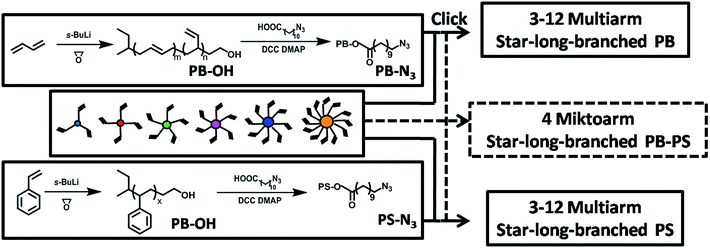 | ||
| Scheme 1 Controlled synthesis of multiarm and miktoarm star polymers by click reaction between multialkynyl organic molecules and azide-terminated living polymers. | ||
Experimental
Materials
All reactions were carried out in anhydrous solvents under an argon atmosphere, unless otherwise stated. Solvents (cyclohexane, toluene, and THF) were distilled from sodium/potassium alloy with benzophenone. CH2Cl2 were dried over CaH2. Styrene was dried with CaH2 and vacuumed stilled with triethylaluminum. Butadiene (polymerization grade) was condensed in a flame-dried flask prior to use. Ethylene oxide (EO) was dried over CaH2 and distilled before use. 11-Azidoundecanoic acid was synthesized according to the literature.25 Compound 7, 8 were synthesized according to the literature.26 All other reagents were obtained from Sigma-Aldrich and used as received.Synthesis of 3-, 4-, 5-, 6-, 8- and 12-arm alkynyl core (compounds 1, 2, 3, 4, 5 and 6)
To a stirred solution of alkynyl substituted bromide (propargyl bromide, compound 7 or 8) (1.1 fold molar equivalent of per phenolic hydroxyl group), and the corresponding phenolic compounds in acetone were added potassium carbonate (1.1 fold molar equivalent of per phenolic hydroxyl group) and 18-crown-6 (0.4 fold molar equivalent of per phenolic hydroxyl group). The reaction mixture was heated at reflux under nitrogen for 24 h, filtered, evaporated to dryness, and partitioned between water and dichloromethane. The aqueous layer was then extracted with dichloromethane twice, and the combined extracts were dried, removed under reduced pressure. The crude product was purified by column chromatography.1H NMR (600 MHz, CDCl3, 298 K, ppm) δ: 7.00 (d, J = 8.8 Hz, 1H), 6.86 (d, J = 8.9 Hz, 1H), 4.66 (d, J = 2.3 Hz, 1H), 2.51 (t, J = 2.3 Hz, 1H), 2.11 (s, 1H).
13C NMR (100 MHz, CDCl3, 298 K, ppm) δ: 155.72, 142.53, 129.68, 114.10, 78.80, 75.52, 55.84, 50.76, 30.78.
ESI-MS: m/z (%) = 420.1 (100) [M+].
1H NMR (600 MHz, CDCl3, 298 K, ppm) δ: 7.45 (d, J = 8.6 Hz, 1H), 7.00 (d, J = 8.6 Hz, 1H), 6.71 (d, J = 1.7 Hz, 1H), 6.58 (s, 1H), 5.06 (s, 1H), 4.68 (d, J = 2.2 Hz, 2H), 2.51 (t, J = 2.1 Hz, 1H).
13C NMR (100 MHz, CDCl3, 298 K, ppm) δ: 158.91, 157.77, 139.72, 133.77, 127.76, 115.18, 106.82, 101.75, 78.30, 75.72, 69.80, 55.98.
ESI-MS: m/z (%) = 582.9 (100) [M+].
1H NMR (400 MHz, CDCl3, 298 K, ppm) δ: 7.04 (t, J = 8.6 Hz, 1H), 6.90 (t, J = 8.2 Hz, 1H), 6.73 (d, J = 1.7 Hz, 1H), 6.61 (s, 1H), 5.03 (s, 1H), 4.72 (d, J = 2.2 Hz, 2H), 2.55 (d, J = 2.3 Hz, 1H), 2.20 (d, J = 9.4 Hz, 1H), 2.15 (s, 1H).
13C NMR (100 MHz, CDCl3, 298 K, ppm) δ: 158.88, 156.71, 155.68, 142.66, 142.06, 139.83, 129.67, 114.09, 106.89, 101.74, 78.80, 78.36, 75.79, 75.49, 69.72, 55.98, 55.84, 50.71, 30.77.
ESI-MS: m/z (%) = 683.9 (100) [M+].
1H NMR (600 MHz, CDCl3, 298 K, ppm) δ: 6.98 (d, J = 8.8 Hz, 1H), 6.84 (d, J = 8.8 Hz, 1H), 6.68 (d, J = 1.8 Hz, 1H), 6.56 (s, 1H), 4.98 (s, 1H), 4.67 (d, J = 2.2 Hz, 2H), 2.50 (t, J = 2.1 Hz, 1H), 2.13 (d, J = 43.5 Hz, 1H).
13C NMR (100 MHz, CDCl3, 298 K, ppm) δ: 158.88, 156.69, 142.13, 139.83, 129.66, 114.09, 106.89, 101.74, 78.36, 75.75, 69.72, 55.98, 50.68, 30.77.
ESI-MS: m/z (%) = 901.0 (100) [M+].
1H NMR (400 MHz, CDCl3, 298 K, ppm) δ: 7.53–7.42 (m, 1H), 7.04–6.94 (m, 1H), 6.68 (d, J = 2.2 Hz, 3H), 6.56 (t, J = 2.2 Hz, 1H), 6.53 (t, J = 2.2 Hz, 1H), 5.02 (s, 1H), 5.00 (s, 2H), 4.67 (t, J = 2.9 Hz, 4H), 2.51 (dt, J = 4.8, 2.4 Hz, 2H).
13C NMR (100 MHz, CDCl3, 298 K, ppm) δ: 159.98, 158.88, 157.82, 139.60, 139.42, 133.72, 127.75, 115.17, 106.85, 106.46, 101.84, 101.71, 78.31, 75.77, 69.99, 69.82, 55.97.
ESI-MS: m/z (%) = 1223.7 (100) [M+].
1H NMR (400 MHz, CDCl3, 298 K, ppm) δ: 7.03–6.96 (m, 1H), 6.83 (d, J = 8.9 Hz, 1H), 6.67 (d, J = 2.3 Hz, 2H), 6.65 (d, J = 2.2 Hz, 1H), 6.56 (t, J = 2.3 Hz, 1H), 6.52 (t, J = 2.2 Hz, 1H), 4.98 (s, 2H), 4.95 (s, 1H), 4.66 (d, J = 2.4 Hz, 4H), 2.50 (t, J = 2.4 Hz, 2H), 2.04 (s, 1H).
13C NMR (100 MHz, CDCl3, 298 K, ppm) δ: 159.95, 158.87, 156.77, 142.13, 139.68, 139.44, 129.69, 114.07, 106.88, 106.57, 101.83, 101.69, 78.35, 75.83, 69.86, 55.97, 50.69, 30.80.
ESI-MS: m/z (%) = 1861.6 (100) [M+].
Synthesis of hydroxyl terminated polybutadiene (PB-OH) and polystyrene (PS-OH)
Hydroxyl terminated polymers were prepared from butadiene or styrene initiated by s-BuLi in cyclohexane at 40 °C by standard anionic polymerization, followed reacting with ethylene oxide at 0 °C, terminated using degassed methanol. All polymer samples were purified by precipitation in 10-fold excess methanol. Both polybutadiene and polystyrene were dried under vacuum and stored at 35 °C. PB-OH (84 g), PS-OH (104 g).Synthesis of azide terminated polybutadiene (PB-N3) and polystyrene (PS-N3)
To a solution of hydroxyl terminated polymers ([–OH] = 0.63 mmol) in CH2Cl2 (100 mL) was added DCC (2.58 g, 12.5 mmol), DMAP (0.38 g, 2.5 mmol) and 11-azidoundecanoic acid (2.84 g, 12.5 mmol) and the mixture was stirred at r.t. for 24 h. The creating solid was filtered and the filtrate was washed with 1 M HCl, followed by saturated NaHCO3 aq. and saturated brine. The organic layer was dried with MgSO4, and precipitated in 10-fold excess methanol. Both polybutadiene and polystyrene were dried under vacuum and stored at 35 °C. PB-OH (8 g × 4), PS-OH (9 g × 4).Synthesis and fractionation of 3–12 multiarm star polybutadienes (PB-3arm to PB-12arm) and polystyrenes (PS-3arm to PS-12arm)
To a 25 mL round bottom flask were added PB-N3 or PS-N3 (0.5 g), 3-, 4-, 5-, 6-, 8-, or 12-arm alkynyl core (compounds 1, 2, 3, 4, 5 or 6), CuBr and 5 mL toluene under Ar. The mixture was stirred at room temperature 1 h, N,N,N′,N′,N′′-pentamethyldiethylenetriamine (PMDETA) was added then and stirred at 40 °C 2 h, color of the solution turned from colorless to pea green. After reaction, the solution was added to conc. HCl/THF (5 mL) and stirred 20 min, and passed through the neutral alumina column. The solvent was removed under reduced pressure and the star polymers were purified by precipitation in 10-fold excess methanol. The methanol was drop to a stirred solution of the resulting polymer (0.40 g) in toluene (40 mL). When the solution was turbid and the mixture was kept on stirring at room temperature for 2 h. Then the mixture was allowed to stand for 24 h to separate into two layers in separating funnel. The lower separating layer was precipitated in 10-fold excess methanol. The purified star polymers were dried under vacuum and stored at room temperature.Synthesis and fractionation of 4-miktoarm star polybutadiene–polystyrene (PB–PS-4arm)
To a 25 mL round bottom flask were added PB-N3 (0.0138 mmol), PS-N3 (0.0138 mmol), 4-arm alkynyl core (compound 2) (0.00921 mmol), CuBr (0.0138 mmol) and 5 mL toluene under Ar. The mixture was stirred at room temperature 1 h, PMDETA (0.0138 mmol) was added then and stirred at 40 °C 2 h, color of the solution turned from colorless to pea green. After reaction, the solution was added to conc. HCl/THF (5 mL) and stirred 20 min, and passed through the neutral alumina column. The solvent was removed under reduced pressure and the star polymers were purified by precipitation in 10-fold excess methanol. The excess of unreacted PB-N3 or PS-N3 was removed by fractionation as the above mentioned. The resulting star polymers were dried under vacuum and stored at room temperature.Characterization
1H NMR spectra were recorded at 400, 600 MHz on Bruker-AV spectrometers. ESI-MS measurements were conducted with a LCQ instrument. GPC was carried on TOSOH HLC 8220 GPC with RI detector at 40 °C using THF as an eluent against linear polystyrene standards. All the molecular weights of linear polymers or star polymers were relatively evaluated by GPC. Molecular weight of linear PBs was corrected by Mark–Houwink calibration using accompanied software. To obtain the absolute molecular weight, GPC-MALLS-RI with 17 scattering angles was applied with DAWN HELEOS II (Wyatt multiangle LS detector, He–Ne 662.0 nm) and Optilab T-rEX (Wyatt RI detector, 658.0 nm) at 25 °C. The refractive index increment (dn/dc) of samples were measured based on the calibration constant of the RI detector and the concentration of samples. Data acquisition was performed using Wyatt Technology WinAstra 6 software.Results and discussion
Synthesis of 3- to 12-multiarm long-branched-star polymers
As shown in Scheme 2, nine kinds of alkynyl compounds bearing 1 to 12 alkynyl groups were synthesized via the nucleophilic substitution reaction between diverse bromo-alkynyl compounds (such as propargyl bromide, compounds 7 and 8) and the corresponding phenolic compounds. Typically, the reaction was carried out under the conditions including molar ratio of –OH![[thin space (1/6-em)]](https://www.rsc.org/images/entities/char_2009.gif) :
:![[thin space (1/6-em)]](https://www.rsc.org/images/entities/char_2009.gif) –Br = 1
–Br = 1![[thin space (1/6-em)]](https://www.rsc.org/images/entities/char_2009.gif) :
:![[thin space (1/6-em)]](https://www.rsc.org/images/entities/char_2009.gif) 1.1, 18-crown-6 as phase transfer catalyst and refluxing in acetone. Six kinds of alkynyl cores were finally obtained as white solid or pale-yellow gum after column chromatograph in the average yield from 45% to 93%. Using this method, we could effectively synthesize other alkynyl cores bearing alkynyl groups with specified number (such as 9, 10, 16, 17, 18, 24, 32, 48 alkynyl cores) in acceptable yield.
1.1, 18-crown-6 as phase transfer catalyst and refluxing in acetone. Six kinds of alkynyl cores were finally obtained as white solid or pale-yellow gum after column chromatograph in the average yield from 45% to 93%. Using this method, we could effectively synthesize other alkynyl cores bearing alkynyl groups with specified number (such as 9, 10, 16, 17, 18, 24, 32, 48 alkynyl cores) in acceptable yield.
As shown in Scheme 1, the linear polymers PB-CH2CH2OH (PB-OH) and PS-CH2CH2OH (PS-OH) were prepared by anionic polymerization using s-BuLi as initiator and ethylene oxide as capping agent. The amount of capping agent exceeded 20-fold theoretical value to synthesize polymers PB-OH and PS-OH with high-capping rate according to literature.27 Fig. 3a and 4a reveals GPC curves of PB-OH and PS-OH as a monomodal and symmetric elution peak (Mn: 20.4 kg mol−1 for PB-OH, and 24.1 kg mol−1 for PS-OH; PDI: 1.03 for PB-OH and PS-OH). 1H NMR spectra of PB-OH and PS-OH are shown in Fig. 1a and c respectively. The efficiency of hydroxyl termination could be estimated by comparing the 1H NMR integration areas of –CH2 (3.64 ppm in PB-CH2CH2OH, 3.29 ppm in PS-CH2CH2OH) with that of –CH3 (0.86 ppm in polymerization initiator s-BuLi), when the molecular weight of polymer is as low as a few thousands. However, when the molecular weight of polymer was up to 20 kg mol−1, the estimation error is too big to represent accurate termination efficiency. In this case, the efficiency of hydroxyl termination was deduced to exceed 97.5% in PB-OH supposing that the efficiencies of both subsequent esterification and click reaction are 100%, and peak area ratio of PB-12arm after click reaction is 96.1%.
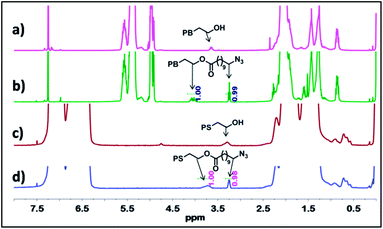 | ||
| Fig. 1 1H NMR spectra of (a) PB-CH2CH2OH (PB-OH), (b) PB-CH2CH2OOC(CH2)10N3 (PB-N3), (c) PS-CH2CH2OH (PS-OH), and (d) PS-CH2CH2OOC(CH2)10N3 (PS-N3). | ||
PB-CH2OOC(CH2)10N3 (PB-N3) and PS-CH2OOC(CH2)10N3 (PS-N3) were easily obtained by esterification of PB-OH and PS-OH with 11-azidoundecanoic acid using DCC and DMAP as dehydrating agent and catalyst, respectively. 1H NMR spectra of PB-CH2OOC(CH2)10N3 and PS-CH2OOC(CH2)10N3 are shown in Fig. 1b and d. The signals of the methylene protons adjacent to the hydroxyl group at 3.64 ppm (PB-CH2-OH) and 3.29 ppm (PS-CH2-OH) disappeared completely. At the same time, the new signal of methylene protons adjacent to the ester group was observed at 4.05 ppm in PB-CH2OOC(CH2)10N3 and 3.72 ppm in PS-CH2OOC(CH2)10N3. The signal of methylene protons adjacent to the azidel group appeared at 3.25 ppm in PB-CH2OOC(CH2)9CH2N3 and PS-CH2OOC(CH2)9CH2N3. Furthermore, 1![[thin space (1/6-em)]](https://www.rsc.org/images/entities/char_2009.gif) :
:![[thin space (1/6-em)]](https://www.rsc.org/images/entities/char_2009.gif) 1 ratio of the integration areas of methylene protons adjacent to –OOC and –N3 indicated that the efficiency of esterification was 100%. Compared to GPC curves of PB-OH and PS-OH (Fig. 3a and 4a), which of PB-N3 and PS-N3 also revealed a monomodal and symmetric elution peak (Fig. 3b and 4b). Moreover, PDI of polymers remained unchanged after the esterification of polymer chain end.
1 ratio of the integration areas of methylene protons adjacent to –OOC and –N3 indicated that the efficiency of esterification was 100%. Compared to GPC curves of PB-OH and PS-OH (Fig. 3a and 4a), which of PB-N3 and PS-N3 also revealed a monomodal and symmetric elution peak (Fig. 3b and 4b). Moreover, PDI of polymers remained unchanged after the esterification of polymer chain end.
3- to 12-arm star polymers (PB-3 to 12arm and PS-3 to 12arm) were synthesized through click reaction between azide-terminated precursors and the organic alkynyl molecules (Fig. S1†). The reaction was carried out by using CuBr/PMDETA as catalyst system and toluene as solvent at 40 °C. The ratio of azide group to alkynyl group was used as 1![[thin space (1/6-em)]](https://www.rsc.org/images/entities/char_2009.gif) :
:![[thin space (1/6-em)]](https://www.rsc.org/images/entities/char_2009.gif) 1 to make sure higher efficiency of click reaction. After the reaction, the residual copper salt was removed by passing through the neutral alumina column. The crude product was fractionated one or two times with toluene/methanol as solvent/nonsolvent system to remove the linear polymer, then the resulting multiarm star polymers were dried under vacuum.
1 to make sure higher efficiency of click reaction. After the reaction, the residual copper salt was removed by passing through the neutral alumina column. The crude product was fractionated one or two times with toluene/methanol as solvent/nonsolvent system to remove the linear polymer, then the resulting multiarm star polymers were dried under vacuum.
1H NMR spectra of PB-3arm and PB-6arm were depicted in Fig. 2 as examples of multiarm star PB. The formation of new structure was confirmed by comparing 1H NMR spectra of the products and the reactants: (1) the signal of hydrogen adjacent to –N3 at 3.25 ppm in PB-N3 completely disappeared and the new signal of methylene proton adjacent to the triazole ring was observed at 4.28 ppm in PB-3arm and PB-6arm (Fig. 2b–d); (2) the signals of hydrogen disappeared at 2.51 and 4.67 ppm were assigned to –C![[triple bond, length as m-dash]](https://www.rsc.org/images/entities/char_e002.gif) CH and –CH2C
CH and –CH2C![[triple bond, length as m-dash]](https://www.rsc.org/images/entities/char_e002.gif) CH in 3 or 6 arm alkynyl core, respectively, and the new signals of hydrogen appeared at 7.59 and 5.18 ppm were assigned to –CH– in triazole ring and –CH2– adjacent to triazole ring in PB-3arm and PB-6arm, respectively (Fig. 2a, b, d and e). Meanwhile, successful synthesis of PB-3arm and PB-6arm was further proved by the accordance of NMR signal of aromatic hydrogens in small molecular cores and corresponding multiarm star PB (Fig. 2b and d).
CH in 3 or 6 arm alkynyl core, respectively, and the new signals of hydrogen appeared at 7.59 and 5.18 ppm were assigned to –CH– in triazole ring and –CH2– adjacent to triazole ring in PB-3arm and PB-6arm, respectively (Fig. 2a, b, d and e). Meanwhile, successful synthesis of PB-3arm and PB-6arm was further proved by the accordance of NMR signal of aromatic hydrogens in small molecular cores and corresponding multiarm star PB (Fig. 2b and d).
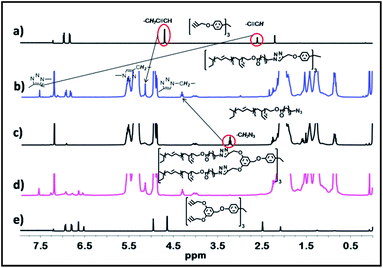 | ||
| Fig. 2 1H NMR of (a) 3-arm alkynyl core, (b) 3-arm star PB, (c) PB-N3, (d) 6-arm star PB and (e) 6-arm alkynyl core. | ||
However, the above accordance could not be observed in small molecular cores and the corresponding multiarm star PS. Because the peaks of aromatic hydrogens in 5-arm and 8-arm core were submerged into the peaks of aromatic hydrogens in PS main chain. Similarly, the formation of multiarm star PS was proved from the disappearance of resonance signal of –CH2N3 (3.24 ppm in Fig. S2c†), –C![[triple bond, length as m-dash]](https://www.rsc.org/images/entities/char_e002.gif) CH, –CH2C
CH, –CH2C![[triple bond, length as m-dash]](https://www.rsc.org/images/entities/char_e002.gif) CH (2.51 ppm and 4.71 ppm in Fig. S2a and S2e†, respectively), and appearance of resonance signal of –CH2 adjacent to N atom of the triazole ring, –CH– in the triazole ring, –CH2 adjacent to C atom of the triazole ring (4.32 ppm, 7.59 ppm, 5.19 ppm in Fig. S2b and S2d,† respectively).
CH (2.51 ppm and 4.71 ppm in Fig. S2a and S2e†, respectively), and appearance of resonance signal of –CH2 adjacent to N atom of the triazole ring, –CH– in the triazole ring, –CH2 adjacent to C atom of the triazole ring (4.32 ppm, 7.59 ppm, 5.19 ppm in Fig. S2b and S2d,† respectively).
Furthermore, the GPC curves (Fig. 3c and 4c) indicated the formation of 3-arm to 12-arm star polymers. The resultant star polymers had earlier elution time than PB-N3 and PS-N3 in GPC curves. These curves kept the same monomodal and symmetric elution peak with small narrow PDI (≤1.04) as PB-N3 and PS-N3 except residual small amount of single-arm linear polymer. The apparent molecular weights (Mn,GPC) of star polymers were higher than those of single-arm linear polymers but smaller than the integral multiple of single-arm molecular weight, because star polymers had smaller hydrodynamic volume caused by its compact structure (Table S1†).
The efficiency of click reaction could be affected by chain-end group concentration (inverse to chain length), steric hindrance of cores and polymer chain, chain-end functionality degree and initial molar ratio of azido terminated linear polymers to alkynyl cores. In 3-arm and 4-arm star polymer (Fig. 5), the higher efficiency was obtained as 93.2% (PB-3arm), 94.7% (PB-4arm), 92.1% (PS-3arm) and 85.0% (PS-4arm). Such higher efficiency is attributed to the below reasons: (1) high-capping rate in anionic polymerization and 100% esterification efficiency; (2) controlling molar ratio as 1![[thin space (1/6-em)]](https://www.rsc.org/images/entities/char_2009.gif) :
:![[thin space (1/6-em)]](https://www.rsc.org/images/entities/char_2009.gif) 1 between azido group in linear polymer chain-end and alkynyl group in cores; (3) controlling concentration of single-arm polymer within appropriate range.
1 between azido group in linear polymer chain-end and alkynyl group in cores; (3) controlling concentration of single-arm polymer within appropriate range.
So far, the number of alkynyl group in core of click reaction has not exceeded five because of complicated synthesis. In this work, we designed and synthesized 5- to 12-arm alkynyl cores with divergent spatial location to decrease largely the influence of steric hindrance from the cores. Thus the efficiency of coupling reaction with the same azido terminated linear polymer (such as PB-N3) did not decrease greatly with the increase of alkynyl numbers in the cores. Noticeably, the highest efficiency of 96.1% was obtained in the reaction for the formation of PB-12arm.
For all polymer chains with various length, the coupling efficiency in the synthesized star PS was slightly lower than that in the synthesized star PB with same numbers of arm due to the more rigid and bulky structures of PS (Fig. 5). The PDI of 3- to 12-arm star polymer was 1.03–1.04, as narrow as single-arm linear polymer, indicating successful synthesis in long-chain star polymers with accurate arm numbers. After once fractionation, 3- to 12-arm long-branched star PB and PS were obtained with purity > 99% and yield > 50% except PB-8arm (Fig. 3d and 4d).
Synthesis of 4-miktoarm long-branched-star copolymer
Miktoarm star copolymers are usually synthesized using living anionic polymerization with stepwise iterative method5 and controlled/living radical polymerization with core-first method or arm-first method.28 However, the above both methods are difficult, tedious and complicated in synthesis of miktoarm star copolymer. One pot synthesis can greatly simplify the procedure, which has succeeded in synthesizing miktoarm copolymer by using identical catalyst system to catalyze two different reactions.29 The procedure can be further facilitated by using the identical catalyst system to catalyze identical reaction in one-pot synthesis of miktoarm star copolymer. Herein, we report the synthesis of 4-miktoarm star copolymer by using the same click reaction between two different polymer chains and the same 4-arm cores.Particularly PS-N3, PB-N3 and 4-alkynyl core were used as 2![[thin space (1/6-em)]](https://www.rsc.org/images/entities/char_2009.gif) :
:![[thin space (1/6-em)]](https://www.rsc.org/images/entities/char_2009.gif) 2
2![[thin space (1/6-em)]](https://www.rsc.org/images/entities/char_2009.gif) :
:![[thin space (1/6-em)]](https://www.rsc.org/images/entities/char_2009.gif) 1 molar ratio to synthesize 4-miktoarm long-branched-star copolymer (PB–PS-4arm, Fig. S3†).1H NMR spectra of PB–PS-4arm are presented in Fig. 6. The signals of hydrogens from aromatic ring in PS and double bond in PB were observed at 6.28–7.22 ppm and 4.86–5.67 ppm, respectively, confirming that the new generated macromolecules included PS and PB chains. The appearance of the new signal of methine proton in the triazole ring at 7.66 ppm and the disappearance of –CH2N3 in PB-N3 and PS-N3 both inferred that the star copolymer was synthesized.
1 molar ratio to synthesize 4-miktoarm long-branched-star copolymer (PB–PS-4arm, Fig. S3†).1H NMR spectra of PB–PS-4arm are presented in Fig. 6. The signals of hydrogens from aromatic ring in PS and double bond in PB were observed at 6.28–7.22 ppm and 4.86–5.67 ppm, respectively, confirming that the new generated macromolecules included PS and PB chains. The appearance of the new signal of methine proton in the triazole ring at 7.66 ppm and the disappearance of –CH2N3 in PB-N3 and PS-N3 both inferred that the star copolymer was synthesized.
Comparing the GPC curves before and after click reaction (Fig. 7a and b), the disappearance of PS-N3 and PB-N3 illustrated that monoarm polymer almostly joined the generation of new miktoarm copolymer; the content of 4-miktoarm copolymer (PB–PS-4arm) in the resulting polymer was high to 95.1%, showing high efficiency of click reaction. The PDI of 4-miktoarm copolymer was still as narrow (Mw/Mn = 1.04) as monoarm PS-N3 and PB-N3, indicating the single composition copolymer was probably synthesized. After once fractionation, the GPC curve of PB–PS-4arm was located in between those of PS-4arm and PB-4arm, further demonstrating that the novel miktoarm copolymer was formed (Fig. 7c).
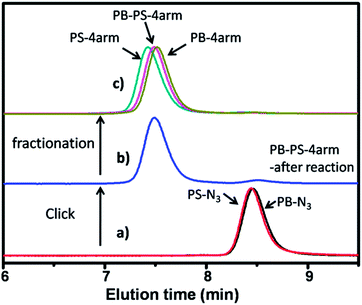 | ||
| Fig. 7 GPC traces monitoring the process of 4-miktoarmstar copolymers synthesis and GPC comparison of PB-4arm, PB–PS-4arm and PS-4arm. | ||
The Mw of PB–PS-4arm (72.4 kg mol−1) determined by GPC-MALLS was almost half of total Mw of PS-4arm (99.1 kg mol−1) plus PB-4arm (55.6 kg mol−1). The narrow (PDI = 1.02), monomodal and symmetric elution peak of three detectors further confirmed the successful synthesis of 4-miktoarm long-branched-star polymer (Table S1†).
However, the accurate composition of 4-miktoarm copolymer needs to be studied further using other detecting method, such as LCCC, TGIC.30,31
Dilute solution properties of star polymers
In the above GPC-RI measurements, apparent/relative molecular weights of 3- to 12-arm star PB and PS were smaller than the corresponding integral multiple of single-arm polymer's Mn, as star-branched polymer has more compact structure and less hydrodynamic volume than linear polymer with the same molecular weight.Therefore, 3- to 12-arm star PB and PS with purity > 99% were further measured by GPC-MALLS-Viscosity-DRI measurement to determine the absolute molecular weight. As shown in Table S1,† the absolute Mws of 3- to 12-arm star PB and PS determined by GPC-MALLS were almost the corresponding integral multiple of single-arm one's. For example, in PB-12arm, the narrow, monomodal and symmetric elution peak of three detectors further confirmed the accurate synthesis of multiarm and miktoarm long-branched-star polymers (Fig. S4†).
Meanwhile, the featured solution properties of star PB and PS were also analyzed by GPC-MALLS-Viscosity-DRI measurement. As shown in Fig. S5,† “U” shape curve, which described the relationship between Rg and Mw, appeared again as characteristic curve in long-chain star-branched polymer similarly to the previous reports.32–35 The phenomena, in which one Rg corresponds to both Mw in the elution curve, have been considered the larger molecular weight species entangled in column packing, delayed elution time and eluted with the smaller ones according to normal GPC mechanism.
The linear part of the curve, for example Mw > 28 kg mol−1 for PS-12arm, was chosen to fitting the exponential scaling relation, Rg = kMwν, where v is the scaling factor, and k is a constant. 0.66, 0.62, 0.57, 0.50 were fitted to be ν for PS-5arm, PS-6arm, PS-8arm, PS-12arm in double logarithmic plots (Fig. 8), respectively. Compared to linear PS in THF (ν = 0.72) and spherical shape polymer (ν = 0.33), these values were slightly lower than that of the linear polymer and reduced orderly with increasing of arm numbers, indicating that morphology of long-branched-star polymer was changed from random coil to hard sphere with the increase of arm numbers.
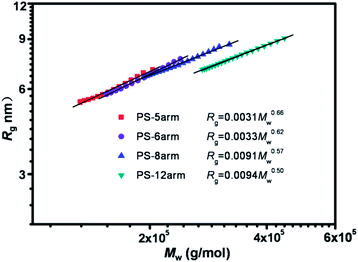 | ||
| Fig. 8 Linear parts of molecular weight dependence of radius of gyration, Rg, for 5- to 12-arm star PS. | ||
The Mark–Houwink–Sakurada (MHS) equation, [η]w = k′Mwα (mL g−1) for star PS was plotted in Fig. 9. 0.69, 0.68, 0.65, 0.56, 0.49, 0.47, 0.43 were fitted to be α for PS-N3, PS-3arm, PS-4arm, PS-5arm, PS-6arm, PS-8arm, PS-12armin double logarithmic style, respectively. These values were lower than that of the linear polystyrene (0.69), and decreased orderly with increasing arm numbers, indicating that the structures of 3- to 12-arm long-branched-star PS was changed from stretched structure to compact structure with the increase of arm numbers.
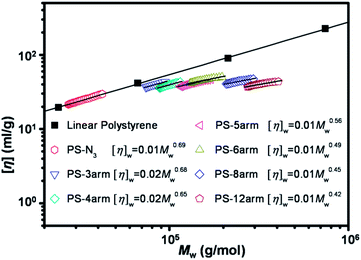 | ||
| Fig. 9 Linear parts of molecular weight dependence of intrinsic viscosity, [η]w, for 1- to 12-arm star PS in THF at 35 °C. The results of linear PS are also plotted as reference. | ||
As shown in Fig. 10, the value of Rg increased and levelled off with the increase of arm-number in star PS and PB. The value of [η] increased first and then reached the maximum value with the increase of arm-number in star PS and PB. According to the Fox–Flory equation,36 [η] = ΦRg3/M, [η] depends on the Rg and M. In star polymer, the value of M increased with the arm-number, however, the increment of increasing of Rg became smaller. Therefore, the value of [η] could appear the maximum in specific arm number. PS-6arm and PB-4arm exhibited the highest intrinsic viscosity in star PS and PB, respectively.
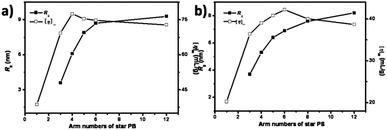 | ||
| Fig. 10 (a) Changing of Rg and [η] with increasing of arm-numbers of star PS, (b) changing of Rg and [η] with increasing of arm-numbers of star PB. | ||
Conclusions
3–12 multiarm star polymers with high Mn of arm (≥20 kg mol−1) and narrow PDI (≤1.04) were successfully synthesized via click chemistry and living anionic polymerization between azide-terminated polymers and multialkynyl organic molecules. Comparing with living species in living anionic polymerization, the azide-terminated polymer would exist stably, persist narrow PDI equally, facilitate the subsequent reaction and have higher coupling efficiency and shorter reaction time. Compared to the previous report, the click efficiency in this work exceeded 85% when the molecular weight of linear polymer chain increased to more than 20 kg mol−1 (over 4–5 times than before). Furthermore the efficiency of coupling reaction did not decrease largely with the increasing of arm-numbers in star polymer. Specially, 96.1%, as the highest efficiency, occurred in the synthesis of PB-12arm. We attributed the promotion of efficiency in click reaction to several reasons as below: (1) high-capping rate in anionic polymerization (>97%) and 100% efficiency in esterification; (2) reducing steric hindrance of reactive chain-end; (3) the design of cores with divergent spatial location of alkynyl group. In 3- to 12-arm star PS, the exponential relationship between Rg and Mw decreased with the increase of arm numbers, indicated that the morphologies changed from random coil to hard sphere with increasing of arm numbers. Intrinsic viscosity changed with the arm number in star PB and PS, and the maximum appeared in PB-4arm and PS-6arm, respectively. 4-miktoarm star copolymer of PB and PS was also synthesized with efficiency of 95.1% and narrow PDI (1.04) by one pot synthesis of click reaction between two different linear polymers (PS-N3 and PB-N3) and 4-arm core. This work broke through the limitation of click chemistry on arm length and arm number in star polymer and provided a high efficient route to synthesize multiarm and miktoarm star polymers with high Mn of arm.Acknowledgements
The authors thank the financial support from the National Natural Science Foundation of China for the projects (nos 21004060 and 51233005).Notes and references
- E. Glynos, A. Chremos, B. Frieberg, G. Sakellariou and P. F. Green, Macromolecules, 2014, 47, 1137–1143 CrossRef CAS.
- S. Jin, T. Higashihara, K. S. Jin, J. Yoon, Y. Rho, B. Ahn, J. Kim, A. Hirao and M. Ree, J. Phys. Chem. B, 2010, 114, 6247–6257 CrossRef CAS PubMed.
- T. B. Karim and G. B. McKenna, Polymer, 2013, 54, 5928–5935 CrossRef CAS PubMed.
- H. F. Gao, Macromol. Rapid Commun., 2012, 33, 722–734 CrossRef CAS PubMed.
- N. Hadjichristidis, M. Pitsikalis, H. Iatrou, P. Driva, G. Sakellariou and M. Chatzichristidi, in Polymer Science: A Comprehensive Reference, ed. K. Matyjaszewski and M. Möller, Elsevier BV, Amsterdam, 2nd edn, 2012, vol. 6, ch. 3, pp. 74–103 Search PubMed.
- F. Liu, H. Y. Tan and T. Tang, Chin. J. Polym. Sci., 2013, 31(12), 1647–1659 CrossRef CAS PubMed.
- N. Hadjichristidis, M. Pitsikalis, S. Pispas and H. Iatou, Chem. Rev., 2001, 101, 3747–3792 CrossRef CAS PubMed.
- F. Liu, D. Wan and T. Tang, Chin. J. Polym. Sci., 2014, 32(1), 51–63 CrossRef CAS PubMed.
- Y. C. Lin, J. Zheng, F. Liu and T. Tang, J. Polym. Sci., Part A: Polym. Chem., 2013, 51, 1664–1671 CrossRef CAS PubMed.
- M. Meldal, Macromol. Rapid Commun., 2008, 29, 1016–1051 CrossRef CAS PubMed.
- B. Y. Zhang, H. Zhang, R. Elupula, A. M. Alb and S. M. Grayson, Macromol. Rapid Commun., 2014, 35, 146–151 CrossRef CAS PubMed.
- C. He, W. D. He, L. W. Li, W. X. Jiang, J. Tao, J. Yang, L. Chen, X. S. Ge and S. Q. Chen, J. Polym. Sci., Part A: Polym. Chem., 2012, 50, 3214–3224 CrossRef CAS PubMed.
- E. Blasco, M. Piñol and L. Oriol, Macromol. Rapid Commun., 2014, 35, 1090–1115 CrossRef CAS PubMed.
- H. Durmaz, A. Dag, G. Hiazal and U. Tunca, J. Polym. Sci., Part A: Polym. Chem., 2011, 49, 1195–1200 CrossRef CAS PubMed.
- O. Altintas, A. P. Vogt, C. Barner-Kowollik and U. Tunca, Polym. Chem., 2012, 3, 34–45 RSC.
- H. F. Gao and K. Matyjaszewski, Macromolecules, 2006, 39, 4960–4965 CrossRef CAS.
- O. Altintas, B. Yankul, G. Hizal and U. Tunca, J. Polym. Sci., Part A: Polym. Chem., 2006, 44, 6458–6465 CrossRef CAS PubMed.
- A. Dag, H. Durmaz, O. Sirkecioglu, G. Hizal and U. Tunca, J. Polym. Sci., Part A: Polym. Chem., 2009, 47, 2344–2351 CrossRef CAS PubMed.
- G. C. Zhang, J. Zheng, F. Liu, Z. J. Zhang, L. Ma and T. Tang, Chin. J. Polym. Sci., 2014, 32(6), 731–742 CrossRef CAS PubMed.
- W. Zhang and A. H. E. Müller, Macromolecules, 2010, 43, 3148–3152 CrossRef CAS.
- H. H. Huang, H. Niu and J. Y. Dong, Macromolecules, 2010, 43, 8331–8335 CrossRef CAS.
- R. Hoogenboom, B. C. Moore and U. S. Schubert, Chem. Commun., 2006, 4010–4012 RSC.
- M. Morton, T. E. Helminiak, S. D. Gadkary and F. Bueche, J. Polym. Sci., 1962, 57, 471–482 CrossRef CAS PubMed.
- A. J. Inglis, P. Pierrat, T. Muller, S. Brase and C. Barner-Kowollik, Soft Matter, 2010, 6, 82–84 RSC.
- J. Gubbens, E. Ruijter, L. E. V. D. Fays, J. M. A. Damen, B. d. Kruijff, M. Slijper, D. T. S. Rijkers, R. M. J. Liskamp and A. I. P. M. D. Kroon, Chem. Biol., 2009, 16, 3–14 CrossRef CAS PubMed.
- M. Malkoch, K. Schleicher, E. Drockenmuller, C. J. Hawker, T. P. Russell, P. Wu and V. V. Fokin, Macromolecules, 2005, 38, 3663–3678 CrossRef CAS.
- H. N. Ji, N. Sato, W. K. Nonidez and J. W. Mays, Polymer, 2002, 43, 7119–7123 CrossRef CAS.
- H. F. Gao and K. Matyjaszewski, J. Am. Chem. Soc., 2007, 129(38), 11828–11834 CrossRef CAS PubMed.
- R. K. Jing, G. W. Wang, Y. N. Zhang and J. L. Huang, Macromolecules, 2011, 44, 805–810 CrossRef CAS.
- C. Galindo, E. Beaudoin, D. Gigmes and D. Bertin, J. Chromatogr. A, 2009, 1216, 8386–8390 CrossRef CAS PubMed.
- H. Pasch, E. Esser, C. Kloninger, H. Iatrou and N. Hadjichristides, Macromol. Chem. Phys., 2001, 202, 1424–1429 CrossRef.
- W. Radke and A. H. E. Müller, Macromolecules, 2005, 38, 3949–3960 CrossRef CAS.
- Y. Nakamura, Y. N. Wan, J. W. Mays, H. Iatrou and N. Hadjichristidis, Macromolecules, 2000, 33, 8323–8328 CrossRef CAS.
- D. J. Frater, J. W. Mays and C. Jackson, J. Polym. Sci., Part B: Polym. Phys., 1997, 35, 141–151 CrossRef CAS.
- W. Burchard, in Branched Polymers II, ed. J. Roovers, Springer-Verlag Berlin Heidelberg, 1999, vol. 143, ch. 3, pp. 113–193 Search PubMed.
- M. Rubinstein and R. H. Colby, Polymer Physics, Oxford University Press, Oxford, 2003, p. 316 Search PubMed.
Footnote |
| † Electronic supplementary information (ESI) available: Additional figure for synthesis and characterisation of star polymers, GPC data and GPC-MALLS data. See DOI: 10.1039/c5ra02168e |
| This journal is © The Royal Society of Chemistry 2015 |

